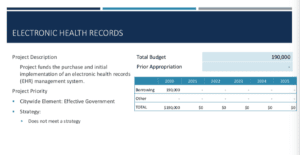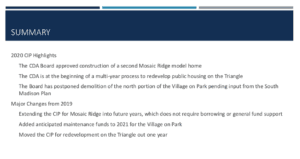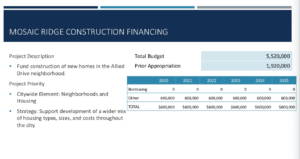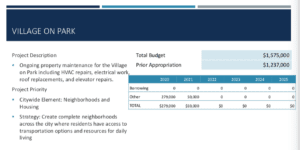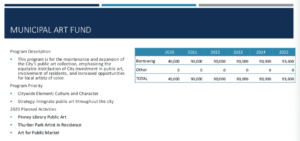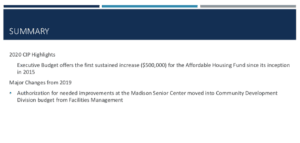This is the first night (from last Monday night) where we hear about the Mayor’s Capital Budget. Staff will be presenting and alders will be asking questions. Finance committee budget amendments will be due Wednesday at noon, public hearing on Tuesday at the Council meeting. If you have input you might want to talk to your alder ASAP.
Here’s the video if you want to watch. The first half hour is 22 other items.
When referring to page numbers, they are referring to this document.
They start off with a presentation from staff. Laura Larsen from the Finance Department does the initial presentation, she does a quick overview. Agencies will be doing presentations now or the next night. For the first time the 2020 plan was built around elements of the comprehensive plan – Imagine Madison. The linked all 195 items in the budget back to the element that they seek to advance. If you look at the full CIP (Capital Improvement plan) 2020-2026 it ranges from $150,000,000 in 24 and 25, up to 240,000,000 in 2022. Embedded in all these numbers are prioritizing and advancing the timeline around bus rapid transit, moving up construction of the Madison Metro satellite facility to 2020. You also see creation of a new land banking fund that appropriates $1,000,000 annual for land banking activities that will support the city’s affordable housing efforts. You also see increased funding for citywide flood mitigation in anticipation of implementing the finding from watershed studies that were funded in 2019 and will have recommendations later this year.
When they look at the capital budget in terms of where funding is going. 50% of the budget is dedicated to strategies that advance strategies in “land use and transportation” element. The next largest element is “green and resilient” which represents 24% of the capital budget. When they look at how the budget is distributed across these elements, they know that projects in all the categories are interrelated and interconnected. For example, many things within land use and transportation are fundamental to the city’s goals and opportunities that lie within “economy and opportunity”. When they look how the budget is funded 54% is by GO (general obligation) borrowing. That is what is ultimately re-paid by the property taxes in subsequent budget years. The next largest portion is revenue bonds, they are bonds that support project sin the water and sewer utilities and they are ultimately paid back by the rate payers through subsequent year rates. She shows a slide that shows the timeline of major projects across the CIP. As the built the 2020 budget they wanted to borrow no more than $100,000,000 annually, and that goal was achieved in each year except 2021 when they see a number of projects stack up including University Ave, ongoing improvements for reconstruction of streets, first major share of Bus Rapid Transit, the second portion of the Metro Satellite Facility, ongoing renovations at Metro’s existing headquarters on E. Washington and the first round of flood mitigation from the watershed studies.
A major new policy change incorporated into the 2020 Capital Budget and CIP was the Horizon list. Each year when we put together the capital budget we see a number of good ideas that meet a clear community purpose but are early in the planning stages, which means the amounts we put into the CIP may or may not be related to scope of what we plan to build and the timeline of what is realistic. So the Horizon list is intended to be a place to talk about the projects we want to more fully conceptualize and we want to bring into a future CIP and acknowledge their importance, but not program them in the CIP. The intent is to have the agencies address the outstanding issues, continue to plan and conceptualize the scope, timeline and budget and bring a budget forward when it has been more fully fleshed out. The Executive Summary includes all of the list of projects that were identified to be on the Horizon list. As you can see it is primarily facilities projects we would pursue in the near future.
When we look at debt services in the plan, she shows a graph where the top line is what the agencies requested, if we funded it all debt service would have reached 20% of the general fund budget by 2024. If we look at the executive budget its the line that trends down slightly. So under the plan the mayor put forth, the debt services stays under 17% for 2021-2025.
Over the next two evenings you will hear from all agencies on what was funded in their budgets. As agencies come before you they will all follow a standard template that will have them walk through the budget in a consistent way, so you will hear about major highlights and variations from 2019 CIP, the goals of individual items, the citywide element and strategy from the comprehensive plan and then planned activities or the timeline for how the project will be completed. She points out the schedule in their packets.
Questions
Alder Rebecca Kemble asks if the debt service graph includes re-appropriations from this year?
Finance Director Dave Schmiedicke says that the graph makes a certain amount of assumptions, yes it does, it assumes there are re-authroizations and that we would actually issue 2/3s of what is authorized each years, including prior year carryovers. It’s roughly $100 – 120 million of borrowing each year, and that is what the graph assumes.
Alder Mike Verveer asks the staff to explain the presentations of the re-authorizations in the budget, he says it took him a little to get it used to because you used to see it for each project. Please explain the change and the rationale.
Laura Larsen says that column came to represent many things. The way it was previously presented in the budget document, it was intrepreted as a projection for the spend down in the project for the remainder of the year. In reality that column was being used as the proxy for how we were determining the timeline of the project in order to information the borrowing in the fall. It the project has planned activities in the first or second quarter of the next year, we would potentially borrow for it and it wouldn’t have a re-authorization or the inverse of that could be. The re-authorization amounts were estimates and they weren’t tied to actual capital spend down or number we were able to reflect in the system. So, the presentation focuses on future appropriations and if we carry balances forward or cancel them from borrowing would be handled as part of the debt process where we are actually able to tie out those amounts and tie the appropriations to what is being borrowed at that time.
Alder Mike Verveer asks about the slides and why some of them have the line item “prior appropriation” and some of them are quite significant and then other slides don’t have that metric. If a slide is silent on prior appropriations should we assume there is none, or were the agencies given leeway to have slightly different presentations.
Larsen says that is the difference between a project and a program. Capital project would have a defined beginning and end, so MMB (Madison Municipal Building) is a perfect example. It has a total budget, it plays out over a number of years, when we get into the project we may have some of those appropriations that were in a prior year, but after the project is done we close it down and don’t invest additional money. A capital program would be where we are manintaining a subset of the city’s assets and we’re putting money towards that set of assets every year to do capital improvements, like the sidewalk program. Every year we are appropriating money towards that program. If you see a total appropriation and prior budget line, that signifies it is a project with a beginning and an end. If you don’t see those fields, that signifies its a program and we’re appropriating new money every single year.
Mayor Satya Rhodes-Conway asks Laura if the council will see the list of re-authorized projects at the time it comes before us as a body. Verveer asks if that document is already in legistar. Schmiedicke says they attached the schedule of re-authorized projects as part of the 2019 borrowing, they also attached a cancellation list for the borrowing. They have to clean up some of that schedule, so we will probably be adding that schedule later. Mayor says that its the same information, only in a different format. Verveer points out on page 5 there is the top 20 list.
MONONA TERRACE
page 104.
Greg McManners reminds them that the Monona Terrace is funded by operating revenues as well as room taxes. The history of their capital budget is that it has been paid out of the Room Tax Fund, not general obligation dollars. They have the amount in front of them submitted to the Room Tax Commission for approval, it has been approved by the Monona Terrace Board of Directors as well as the finance committee.
Their highlights include that they are submitting a capital budget $345,000 less than it was at this point last year. They continue to look at the capital budget as a placeholder and make sure they have the projects identified going into the budget year and then decide if the projects are actually needed. If they can be supported for another year, they look at expenses and lifespan of the project that they are doing and the immediacy of the need to address it. One of the major emphasis of this budget is that in 2018 they rented about $400,000 in equipment in order to provide for customer requests. They are looking at a 3 year payback for any equipment that they pay in the building and that is in the form of rental payments. They are trying to be more robust with the products they have on line because they are finding that as organizations and requests become more sophisticated they don’t have the equipment but they have more requests. If they can pay it back in 3 years they are trying to a add it to their inventory.
The building and building improvements program description includes increasing efficiency and reducing maintenance costs and improve customer experience at Monona Terrace, and they typically look at culture and character as one of the city-wide elements and the want their customer experience to be first class, so they are looking at the architecture, the building, the AV presentations, and what they need to do mot make sure their customers are satisfied and they continue to rate very high as it relates to customer satisfaction and its one of the models they use to determine if they are serving their customers to the best of their ability.
Under machinery and equipment the other thing they are looking at recertification of their LEED program. He told the mayor they are 4 points short of being platinum, they are working on that. The biggest element of getting 2 additional points is a 24 month commissioning process they are going through to make sure all of their equipment is working according to its design and its not easy because it hard to identify which projects need to be updated so they put some general capital improvement money in the budget o make sure the dollars are there if they identify a piece of equipment that doesn’t meet their standards of efficiency they can address it immediately.
Questions
Alder Donna Moreland asks about put on the summary page that they have $345,000 saved since 2018, how does it compare to 2019? McManners He says it’s $150,000 since 2019.
Moreland asks about the equipment purchase, she assumes some of it is technology, with technology changing so rapidly do you think purchasing it the right way to go? McManners says that they need to look at that for sure. They had a client that came in an asked for 145 laptops. Does that make sense to buy 145 laptops, the answer is no, they need to look at the process and what is being requested. If it is something they feel has longevity to it, that’s going to be 3-5 years or more and a payback of less than 3 years then they are seriously going to consider that. Motor trusses, curtains, drapery have a significant longevity to them, technology is a different situation and they look at that very closely to make sure the obsolescence of that will not wear out before we get the money back from it.
Alder Shive Bidar asks about the new line for the 2023 and 2024 which are the larger amounts that are non-GF GO borrowing. In previous budgets it was all room tax and those line produce pretty well, what is this new category. McManners says that 2023 and 2024 is the 10 year renovation period. They have been typically paying for that with cash. The money in those budgets right now are estimates. He told the board and staff it should not be an estimate. It might be a bit inflated right now, they don’t have many major purchases right now. The first renovation they did in 04 they took down permanent walls and fixed walls in the building and in 2014 we did the restroom upgrade. They don’t have anything like that in the present project. He anticipates those numbers are high for what they need. The discussions about how it will be paid for is on-going, obviously the room tax fund is funding a significant amount of different projects than what occurred in 2014. There is probably not enough money in that fund currently to support that renovation. So they are looking at options. According to state law they have to have debt to be able to use the room tax. Debt is a requirement of them using the Room Tax as far as Monona Terrace is concerned. They have an on-going cost, the question is how much do they want to borrow for. Hopefully they will have a better idea next year.
Alder Sheri Carter asks about them meeting with other venues regarding events, when they are looking at upgrading are the events asking for more technology or do we need the infrastructure to connect to the technology that they are bringing in. McManners says they think the infrastucture is there, they have a very robust wifi system. They think its one of the strongest of convention centers in the country, so they are really comfortable with that. The interesting thing is what the customers ask for, the spaces are fine, but they are asking for furniture and other things. They are listening to decide what the improvements are over time. One of the things they tried to change this year was to make the spaces more interactive. We are still living in an experiential economy and people want the experience of being able to sit down with someone and have a glass of wine and talking about common issues. So they are trying to morph the building into a more interactive venue but the limitations are the architecture of the building. That likely won’t be changed due to the copyright of the person who designed it. So they try to work within the limitations of the building’s footprint as well as the interior spaces, but make it interesting and lively and make the clients workable for the clients.
Carter asks about the renovations every 10 years. In 2004, what was the renovations. McManners says that they had fixed walls in all the meeting spaces, so they 8 800 square foot spaces that were not expandable. They tore down the walls and put in movable walls. They increased their occupancy from 29% to 42%, the building is about 48% so it was an expensive venture but it has really worked out well. The second thing they did was in terms of LEED in 2014 they did the restrooms – waterless urinals, efficient spaces and more modern.
Carter asks about 2014. McManners says that was 2014.
Alder Barbara Harrington-McKinney asks about process improvement and asks him to say something about where that process is and how it is going to “provide a safe environment for clients and guests and to increase overall customer satisfaction”. McManners says “thanks for that question”, he says they have been working on the statewide Malcom Baldridge award since 2004. It’s a world class building, second to none, but is there a world class organization running that building, so they asked themselves those questions. They embarked on the venture of performance exellence and process improvement is a part of that and they were trying to make sure they were measuring the right things, spending the dollars they have efficiently and going through the process for quite some time. To make sure they are an organization that is supporting the building the best way possible. As they look at safety and security, it is the number on thing that is talked about and it continues to be, it has morphed so much since 1997 when the building was built. The building has gone through a Department of Homeland Security assessment to make sure the building is as safe as it possibly can be and yet inviting to our customers and that is a fine line. They do not want to put up metal detectors or make it difficult for people to enter the building. The are looking at what they are trying to accomplish without having an adverse affect on their customers. Obviously, we live in a different world these days, but we need to be prepared for those things, the process is ongoing and will continue to be as things happen in this country and we need to be aware and prepared for them.
McKinney asks if that will impact the budget, do you need upgrades to get to that level. McManners says they made some upgrades 2 years ago – command center, cameras . . . they tried to make the building as safe as it possibly can be. They are still looking at some locking mechanisms where the command center could lock down all spaces with the push of one button. They are still investigating what they could potentially do to mitigate any type of threat, but its not an easy answer and not inexpensive. It’s a matter of weighing the risk vs. reward and they continue to do that on every security issue that comes before them, as well as customer related issues.
Verveer says he doesn’t have a questions, but as a point of personal privilege he says that “speaking of world class institutions, Greg, we’ve been blessed with you as a world class director” and he shares the news that McManners has announced his retirement to the board and the Mayor and some stakeholders in the community. This being you last Capital Budget presentation (I know you will be with us for the Operating Budget), he wants to say that you’ve been a tremendous director and you know I and all of my Monona Terrace Board colleagues really think the world of you. So, again I don’t know if the whole council knew of your decision to retire, but I wanted to not only take a moment to say you are world class but to let folks know that you will be leaving us at the end of the year. McManners says thanks and its been an honor to serve and its a great facility and great staff and its been an honor to serve the residents of Madison, Dane County as well as the State of Wisconsin, thank you.
PUBLIC HEALTH
p. 131
Dance County! Whoohoooo!!!
Janelle Heinrich, the Public Health Director for Public Health Madison and Dane County says they has shared operating costs by equalized value of city and county tax levy, so its currently 56% county and 44% city contribution to the operating budget. That is what supports the borrowing as well. They have one item introduced in 2020. It a request to borrow $190,000 to support the purchase of electronic health records, they currently don’t have any system that allows for interoperability with any of the platforms that they use to deliver their services, nor for the support of billing. They may have a requirement for them to do this shortly, with regard to funding and projects that they administer. What this will do will hopefully reduce time and they will be more efficient and eliminate duplication, increase security by not having paper copies when out of the office, and it will also increase their ability to increase revenue. They are hiring a billing specialist and in the absence of an EHR we could probably generate $60,000 more in revenue every year. And that is a low estimate, with a EHR they could generate $300,000 and that will more than pay for the annual fees to operate an EHR and support better community care coordination as well.
Questions
Bidar asks about company they are going to use or is that an RFP process. Heinrich says that they would put it out for RFP, they hired an LTE to do an analysis of the needs based on the requirements from the state and the programs they currently operate and start the investigation on which services they needs. They think there are 4 vendors that they think may be a good fit, one of whom may be in our backyard. They have talked with city IT about the process and they would launch that and support implementation in early 2020.
Bidar asks if one of the RFP requirements is going to be how they records will interface with larger health care systems. Heinrich says “yes, absolutely” that is a bigger goal to improve coordination between our services as well as the providers in the community.
Moreland asks about costs of training. Heinrich says there are some numbers built in for implementation, which includes training and staffing and administration of that. They would recoup this costs in an ongoing basis. It does’t include the annual fee which they would hopefully generate through the revenue.
More asks about how they arrived at the $190,000. Heinrich says there was an LTE that did that analysis. They have done a significant amount of research to determine the average costs, especially for the ones that would serve their purposes best.
Moreland asks if they need to add additional staff. Heinrich says not, they reclassified a position that is out for posting right now that the person could absorb that, they also think that because they anticipate they will have reduced time on charting, up to 25% minimumally, they could probably redirect some staffing to support that if it grows beyond the capacity of one person.
PLANNING, COMMUNITY AND ECONOMIC DEVELOPMENT
CDA REDEVELOPMENT
Adam Pfost is the Budget Manager in the Office of the Director of PCED, he supports Nan Fey in her Interim Role as Director of the Department. Natalie Erdman was the Executive Director of the Community Development Authority and since her retirement a new director has not yet been appointed as her permanent position is not being replaced. He appreciates that Matt Wachter is joining him today if we get into questions that are more detailed. He says the redevelopment side is charged with encouraging safe neighborhood, the provision of healthful homes, and supporting adequate places for employment. The budget supports those parts of our mission and also align with the priorities for the city of Madison. He says that the lines in the chart diverge significantly between 2019 and 2020 and that change is driven by including activity fo Mosaic Ridge in the budget. That is funded from CDA funds, it is not a request for additional borrowing or additional city support. There are three different components to their request:
Mosaic Ridge is a project ot develop single family homes in the Allied Drive Neighborhood, the Community Development Authority purchased properties and has sold the lots and works to sell the lots and develop housing. The lots have been sold to Section 8 participants, Hbitat for Humanity and market rate buyers. The amount of money they are requesting looks large, in reality this is a revolving balance, where the Community Development Authotiry will develop a house for a buyer, they will sell the home, the proceeds come back into the fund and the same dollars are spent again, really it is the same $600,000 being spent over each of those years. Those are funded out of the CDA balances.
This is a commercial property the CDA owns on South Park St., the request is ongoing maintenance and safe operation of the property. The largest expense is in 2020 for $279,000, $115,000 is for a roof replacement. They also have expenses in 2021 where they think they will need additional maintenance going forward. The funding for this comes out of the operations of the property, tenants pay rent and they use those funds to support on-going maintenance of the property. A significant change from previous years is that they discussed redevelopment of the north half of the building as a significant priority and it continues to be a priority for the board, but the project was delayed because Head Start has a daycare in the building and they are looking for a new location and they are supporting them in that search, that has extended their timeline to support that asset in the community. They are also looking forward to the completion of the South Madison Plan to determine what that asset could best look like, they want to see how that turns out before redevelopment. It’s still a priority but they are looking forward to ongoing discussions.
Public Housing Development
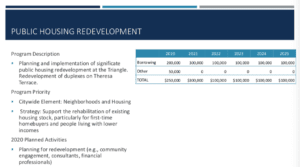
This is the Triangle, it will occur in multiple phases, this asks for GO borrowing that will be repaid by the CDA. These funds are planning funds to address what the redevelopment will look like and for significant engagement with the residents of the area. The property on the Triangle, that was also pushed back as the Triangle Neighborhood Plan was completed. The plan calls for the 370 residents, 80% with physical or mental health challenges with a median income of about $10,000 a year. This is a vulnerable population and the planning dollars will help address what that redevelopment could look like. This borrowing is for the planning, the actual cost of the development will come from Low Income Housing Tax Credits, CDBG funds and any other funds they can bill through the redevelopment deals.
Questions
Alder Marsha Rummel asks about the future improvements to the other properties, she is thinking about F-35s a lot and both Rethke and Truax are in the flight plans, are you thinking about sound remediation and abatement for those residents. Pfost says they haven’t talked with the board about sound remediation, but that it could be an issue. There hasn’t been any discussion yet about what they would do if that were to occur. Rummel asks them to start thinking about it.
McKinney asks about the three projects and she says it falls under “neighborhoods and housing” and so is there a projected next steps after these three projects. How do you determine the next projects or area to work on. Pfost says that the Triangle is an enormous undertaking to make sure it is done well, their planning effort will be focused on how to do that in a meaningful and responsible way. Looking forward, after they have an Executive Director on Board and a few other key leadership positions, they will be able to look beyond that time frame. Right now they are looking at the public housing redevelopment.
McKinney asks where their other public housing area is. Matt Wachter says it is spread across the city, Truax is the other large site, S. Park St has units, as does the near east side, but there is also scattered site single family and duplexes literally all over the city. The CDA 3 years ago did a strategic planning effort to look at next step phases. McKinney asks if the next step is to look at the housing scattered throughout the city instead of one major area. Wachter says HUD is changing the programs as we speak so the CDA will be reacting somewhat to what HUD is directing us to do with the housing portfolio.
Alder Tag Evers asks about Romnes and if it is anywhere on the horizon. Matt Wachter says that the board hasn’t talked about what the future steps would be. He says given staff capacity and size of the Triangle, that is the only thing that is mapped out. Evers says since he is on the CDA Board he should probably ask that question of himself.
Sheri Carter asks how many properties the CDA oversees. He says he couldn’t say with any certainty. He says they not only own large properties like the Triangle, but an enormous amount of single family and duplex homes across the city. Carter asks how long it took them to renovate Truax. Wachter says each project is about 3 years for planning, HUD processes are rather elaborate, so a three year minimum. Carter asks about Mosaic Ridge. That has totally transformed a neighborhood. How many lots do you have left in Mosaic Ridge. Wachter says they are under construction for 2 so its 14 or 15.
Rummel says they are an agency with a lot of power but you wouldn’t know it from this budget, you have the authority to issue bonds and use it for good purposes and you mentioned that you have been doing planning, can you remind us what kind of approach you will be taking to use the power to build affordable housing.
Mayor interrupts and says its not fair to ask the two of them. Rummel says Matt would know. Mayor says neither one of them are actually at the CDA. Someone says “Matt was at the CDA”. Mayor says part of the problem is that they don’t have a permanent director right now, that is step one. Planning is step 2, flexing their muscles is step 3, and that’s a thing I have asked them to do. Rummel says with all due respect, Matt wrote our housing strategy program and he knows an awful lot. I assume even tho he is not in charge right now he could at least throw out some ideas. Wachter says they have tools they are not using at all, you mentioned bonds and financing tools. Those are things that we, collectively, actually me, would look at as the broader things to look at beyond the Triangle. HUD is actively looking to change the public housing programs to more quickly adapt to the market place.
Carter says that the CDA is the umbrella for our most vulnerable residents in the City and if we had a City without the CDA we would be up the river without a paddle and she wants to commend, and for full disclosure she is on the CDA, so she will keep her pride at a normal level, but she wants to say that the CDA has done a great job and the feedback that she gets from her residents when they need to find a place to live and find it relatively fast, and even though we have waiting lists, its the CDA that comes through.
PLANNING
Heather Stouder, the Planning Division Director says she has a straight forward presentation. One item.
This has been before you year after year as the Planning Division’s sole capital budget request. When you look at the CIP, it hasn’t changed since last year. They are requesting $40,000 in 2020 and $90,000 in years to follow and a slight increase in 2025 for inflation. They were and still are dealing with a back log of funds from previous years. They asked for $0 for 2019 due to the back log of funds. This is a very flexible fund that requires variability in funding over the years, some projects may be years in the making and hundreds of thousands of dollars, others are small programs for utility art boxes etc. They have been agressively spending down the fund and looking forward in working with Karin Wolf they will be down to zero. They have a path forward to spend down the fund. One of the things that causes them anxiety is the need to conserve the existing public art collections as it continues to grow. The conservation efforts, particularly for the older pieces can be quite expensive. She doesn’t think they will have any trouble spending the money they requested over the next 5 years. They are solidly in the “culture and character” element of the comprehensive plan and the strategy is to integrate public art throughout the city. One of their focus areas is to ensure that there is an equitable distribution of art across the city, so they are working to map the public art collection and make sure that we aren’t focused on the most visible parts of the city but that we are reaching areas that don’t have an investment in the arts at this point. Secondly they are hoping to involve residents to a greater extent so they aren’t placing art in a neighborhood without resident engagement. Finally they are increasing opportunities for local artists of color to contribute to our public art collection. Some of the highlights of 2020 are listed on the slide, they are different than in the budget book. She says Pinney Library, Town of Blooming Grove Thurber Park, close to Darbo-Worthington neighborhood that has a small metal building for an artist in residence, so the artist can have a studio embedded in the neighborhood and work on pieces that will be placed in that general area in the year to come and finally art for the Public Market. They expect a strong investment in that space.
Questions
Verveer asks about the Municipal Art Fund being at $0 in 2020? At what point would that be. Stouder says that Karin has looked at the projects we are committed to or working toward and I said that to ensure people that we are spending down the reserves that have been in that fund in the past 5 years. They have a hefty price tag for the Public Market piece, the Thurber Park and a total of about 175,000 in anticipated spending by the end of 2020 when we look at the anticipated work. That excludes the Shift project, which got a special appropriation in the University Ave corridor. That $175,000 is separate from the $150,000 dedicated to the Shift project. When you look at their remaining balance of about $30,000 we will be putting that towards art for Darbo-Worthington area and they will need to use a significant amount of the 2020 request to go towards that area as well.
Verveer asks what the estimated balance is in the art fund as of today. Stouder says today they have just over $200,000 remaining, last year they have over $350,000. Verveer says that is why he was asking, last year that was in the information they received. This is the first year they haven’t allocated more funds, and that is why its only $40,000 this year but in future years we need to build it up again to a more robust amount. Verveer asks about the very popular program of the Utility Box art, do you know what the plans are for maintenance for the utility box art? She doesn’t but the ones that are a few years old still look fresh and new, but she will get back to him on that. Both Verveer and Stouder asked Carter if she knew the answer and she said that she hopes it continues and they look absolutely wonderful along with the Downtown Doors art, she thinks its just fantastic and its just another way to connect with our guests that come visit Madison. Stouder clarifies that she believes the project will continue, she thought the question was about the maintenance of the pieces over time. Verveer says it was both, he wanted to know the short term and long term plans. He thought every couple years there would be a call for more art and we’d have funds in the municipal art fund to expand the program. Stouder says that is definitely the plan. Verveer says that is why he is concerned about drawing down the fund. He says another example is the art at the confluence of art at State Street and the Campus Mall, he says they needed an amendment to get funds for cost overruns because the TIF district had closed. Stouder says yes, they need every dollar they are asking for and the anxiety that they have relates to the conservation fo the entire collection and they want to make sure they have enough for major conservation efforts as they arise.
Alder Patrick Heck says this doesn’t seem like a lot of money when it comes to the art world. Alder Verveer mentioned TIF funding as another mechanism, he assumes for many of the projects there are cost sharing opportunities. Stouder says the Arts Administratior does a wonderful job of seeking match funds and private investment in art as well. Another fund that will begin shortly is the Percent for the Arts, that will relate to certain capital projects, such as the Public Market, where some of the funding will be able to come from the Percent for the Arts fund as well.
Moreland asks how the projects are chosen and is there a specific program you have in place to really encourage residents of color who are artists. Stouder says that the Madison Arts Commission makes recommendations to the council, Alder Carter may be able to talk more about that. The most exciting thing they have now related to artists of color would be the Thurber Artist in Residence program where the artist will be compensated and have a studio at their disposal, that should be coming before you soon. It was just introduced at the last council meeting and it will be before them on the 17th or shortly thereafter.
McKinney asks about equitable distribution of art across the city, so if a resident would want to see that list where would she direct a resident to go. Stouder says you can direct them to her, they are almost done with their internal compilation into a map. She says she will work with Karin to address their questions. McKinney asks when the map would be completed. Stouder says its an inventory at this point and then they want to add the investments so they have an asset management plan for their art work, its a couple months from completion. She says that its really important to have the investments on there and she wants that included.
Moreland asks if the art work rotates through different neighborhoods. Stouder says not the Municipal Art Fund work, but they do have a program called Blink, which is for short term art projects that pop up for a matter of months in a neighborhood. They don’t usually travel to different neighborhoods, instead it supports short term art across the city. The Municipal Art Fund is mostly used for permanent structures, more significant structures both indoor and out door, with some exceptions. If there are large murals as paintings, they can move throughout Municipal facilities. They have a collection of art handing, many of which are in this building now, that may have come from other facilities over time, but the majority of the funding is for significant structures that are placed in a single place long term.
Carter was going to point out the Blink project that was a tribute to Otis Redding, which was on the East Side as something that was there temporarily and could have been in any other neighborhood. Our commission is very embedded in the art community and one of the communities that is very diverse and respectful of each other is the art community.
Evers invites people to the dedication of the sculpture the Badger by Harry Whitehorse, this Friday at 2pm at 1602 Monroe St in District 13 at the Corner of Regent, Monroe and Breese, you’re all invited.
Rhodes-Conway cautions them that they are only half way through and asks them to confine their questions to the capital budget, they do have accesss to the staff in other venues and at other times.
COMMUNITY DEVELOPMENT
Jim O’Keefe form Community Development Division introduces Linette Rhodes who oversees the CDBG unit and oversees much of the housing work that they do. Also Sally Jo Spaeni from the Senior Center is also here. The 2020 budget is pretty straight forward, he only wants to bring two items to their attention. The first is the increase in the affordable housing fund. The executive capital budget increases $500,000 from $4.5M to $5M per year in 2020 and thereafter. This is the first sustained increase in this fund since its inception in 2015 and appropriately so, recognizing rising cost pressures on land costs, labor and construction. The second item is the first planned improvement to the Senior Center, they types of projects that had been previously in the Engineering Facilities Management budget. They show up in the CDD Budget this year.
Affordable Housing Development
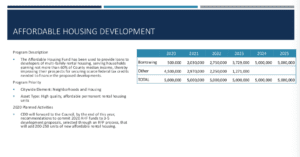
The affordable housing fund has been the centerpiece of the community development division’s capital budget. It’s focus to date has been on expanding the supply of affordable rental housing. Affordable meaning housing that is available to household earning not more than 60% of the Area Median Income (AMI), which for a single person household is about $42,000, for a 4 person household its about $60,000 annual income. The strategy they have employed is to maximize the impact of city funds by matching federal low income housing tax credits. We use city dollars to secure very powerful and very scarce federal tax credits. To date we have supported 17 development proposals representation 1250 new apartment units, 1100 of which are affordable. 9 of the projects are completed and occupied, 4 more are under construction and the remaining 4 are in final design and planning stages. Our nearly $24M of city investments have helped secure $150M in federal tax credit and supported development costs in aggregate of more than $250M. We have invested $23.7M of city tax dollars and they have been used to secure $150M in federal tax credits, 17 projects and $250M of development costs. All of the developments have been selected through competitive processes. The funds for 2020 would be used to support proposals that are in the current RFP process and they will bring their recommendations later in the fall, probably in October. Two other quick notes. One is that the fund continues to benefit from the receipts from TIF districts that would be normally closed but by state law are allowed to remain open for an extra year to be used to support affordable housing activities in municipalities. We’ve taken full advantage of that provision in state law. The second is just to make sure you understand that funds that would be deployed from the 2020 budget will support projects that will not begin construction until 2021 and be completed until 2022, but it’s the nature of the way the funds are used. To be recognized by WHEDA to leverage those tax credits they have to be not just planned for, but actually budgeted.
Housing Consumer Loan Programs
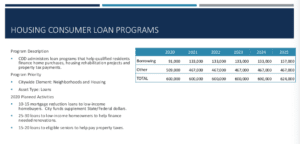
Most of what they do is around rental housing, they are also involved in work to support and maintain home ownership. The line in their budget under housing consumer loans reflects three separate programs, one that helps households gain homeownership, another that helps eligible homeowners undertake repairs or renovations of their property and a third of which allowed eligible seniors to take advantage of equity in their homes to finance property tax programs, they are somewhat modest programs. The items in the capital budget supplement funds that don’t show up in the capital budget that come from state and federal resources. They use those state and federal resources as they can and draw on city resources if the other funds are not available or appropriate.
Bridge Lake Point Waunona Community Center
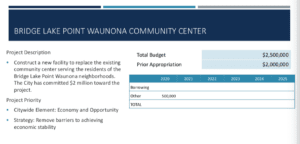
This item has been in the budget for a couple of years, it anticipates a replacement community center serving the Bridge-Lakepoint-Monona neighborhoods. There is a $2M authorization already approved to support the project, which is federal CDBG dollars and some city dollars that were realized by the closure of a TIF district in this part of the city, unlike what we use for housing, this was the city share of the surplus that was available when the district closed. They show a half million dollar contribution from private sources. It’s much more likely that the private fundraising campaign will have to exceed a half million. That work is underway and while they hope to see construction in 2020, he thinks that the scale and timing will hinge on the pace of the capital campaign.
Senior Center Building Improvements
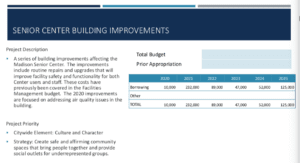
Lastly, this is a series of improvements to the senior center that will take place over the next 5 years and they are the types of projects that would be financed under the facilities management budget, but at the request of finance they are now in the CDBG budget. They are improvements that will improve the safety and functionality of that facility.
Questions
Alder McKinney asks if routine repairs, upgrades, vandalism, is that incorporated in the budget? How is that reflected in the overall budget?
O’Keefe has to ask if this is for the senior center or more generally? She says more generally about maintenance for all the properties. O’Keefe explains that that don’t have a capital line item for neighborhood centers. McKinney says she isn’t asking about neighborhood center, but the budget in general. Someone (I think Laura Larsen?) says that there is money in the Facilitites budget for unanticipated building repairs that come up, in city owned buildings. O’Keefe says he thought she might be asking about neighborhood centers as we have had some issues there. McKinney says no, she just wanted to make sure there was money in the budget for unforeseen costs.
Alder Patrick Heck asks about the Affordable Housing Development projects. He says that the TIF proceeds are shown as ramping down across the CIP, is that because there are no longer TIDs that are closing where you use the one year, or are there other TIF proceeds. O’Keefe says that he thinks what you are seeing is the tail end of the use of $15M in TIF proceeds used in 2015. The closing of TIF districts is not a regular routine or sometimes predictable thing, so they take advantage of those things when they occur.
Heck says “It’s a plan”
David Schmiedicke says they work with Economic Development Staff to identify when TIDs might close and that is how they put in the forecast about how much increment will be available. Schmiedicke says Jim is right, there was a lot provided by the closure of TID 32 in 2018 and so the program has been living on those dollars for the last couple years and those will run out.
Alder Rummel asks why the Senior Center is now in your budget. Is its because its an element. O’Keefe says that it was a request to recognize it as part of the Community Development Division and all costs associated with it should be reflected in their budget. Rummel says “so wrap your arms around it, ok”
Laura Larsen once again says it follows the same logic of putting a police station in the police capital budget or fire station in the fire department budget, so showing the facility projects in the agency that owns them. The construction and execution of those capital projects is still done in close cooperation with the engineering department.
Rummel is still curious, in future years a quarter of a million dollars will be in facility repair. I know this is the new way of doing budgets, I’m just trying to get my head around the new way.
Larsen says it is consistent with how they show facilities remodel and renovation projects in other parts of the capital budget. They were striving for consistency.
Rummel says she will talk more about that later.
Rummel asks if they have ideas about the extra $500,000. Is it just more section 42 RFPs. That seems like we are putting all our eggs in one basket and its kind of a narrow range. It does good stuff, but it does a certain thing, can we have other things besides that to create more affordable housing. Have we thought about that?
O’Keefe says they have and the mayor’s made it clear that its her intent that we move beyond moving section 42 projects. They are in the midst of working with the interagency staff team around housing issues to determine how those funds might best be used. When the fund was created it replaced, you might recall, a very rigid Affordable Housing Trust Fund. It was designed in part to increase the uses. The fact that they have consumed that entire resource in support of rental development projects, doesn’t speak to the flexibility that exists within the program, but perhaps to the first priority of the city at that point. To add as much housing stock as they possibly could.
Moreland asks about the funding source “loan repayment”, where does that number come from? Linette Rhodes asks if she is asking Consumer Lending or Affordable Housing Fund? Moreland says she is asking about the $465,000. Rhodes says that this is the homeownership programs and all of their loans go out with a mortgage and a note and people pay them back. So everything is a revolving loan fund and for a long time they have not borrowed for those loans because they have repayments coming in and they leverage state and federal funds pretty heavily. So they have been working off of their reserve fund process. Homeowners usually live in their houses for 7-10 and then they pay the city back and that is how they generate revenue to support the programs.
Moreland asks if this is a conservative number that may take into account default loans. Rhodes says they have a very low default rate, less than 1%.
Verveer asks about the Affordable Housing Fund and looks forward to conversations the mayor will be leading about the criteria for the Affordable Housing Fund, including the % of median income. Are there any reserve funds available in the Affordable Housing Fund for projects we made previous commitments to that haven’t met the requirements of our awards. Or are you literally starting from scratch and there will be exactly $5M available if the budget is adopted. O’Keefe says there was one project they committed funds to (about $2M) which was the 3rd permanent supportive housing project slated to be built in the 1200 block of S. Park St. Heartland Housing decided to return the credits and the project was cancelled. Some of the money is tied up in the ownership of that property ($600,000) that the city owns, and when they dispose of it the funds will return to the Affordable Housing Fund. The balance of that money is funding we anticipated that they anticipated would be available to support the Judge Doyle Square Development. He says those funds aren’t necessarily a reserve at this point.
Verveer also asks about the Senior Center improvements, he has had a strong interest in converting the Senior Center Courtyard from something that is only for the Senior Center to something that is available to the greater community as a city park. He discussed this a year ago and they have had preliminary conversations since then, also with the mayor. He is thinking about a capital budget amendment in this regard. It is his intent to offer an amendment to transfer the Senior Center Courtyard funding, which they mayor proposed in her executive budget in 2021, to move that to a parks project. Matt Wachter and his team are working on real estate issues in that regard. He wants to clarify that CDD has no concerns about this arrangement and are supportive of it. They will be able to use Park Impact fee money instead of G.O. borrowing for the changes. O’Keefe says they have discussed this and are open to the transaction you have suggested. Sally Jo Spoeni says the Senior Center is in support, hoping that they can bring more awareness to the community about where the Senior Center is and what they do. They are kind of hidden there and they think a park would help. They also have had conversations indicating that they would still be able to hold their functions there by letting them know early in the year so that the park could be reserved for senior center functions and the reservation would come without a fee or at a reduced cost. So, they are in favor of that.
Verveer asks if the parks staff have made that committment in prior meetings they have had. She says yes. They also talked about incorporating some pollinator gardens and bee keeping instruction into the Senior Center and this would provide a wonderful space for that.
Verveer asks her to explain how urgently needed the repairs are given the tripping hazards and so forth. Spoeni says that earlier in the year they did a physical needs assessment on the Senior Center and they identified several safety hazards exist in the court yard. Specifically there are some pavers giving way and causing some pretty major trip hazards. All the curbing is cut up with planting structures and that curbing is broken and falling apart probably due to the difficult snow removal. There are sinking pavers, broken sidewalk squares, broken curbing and ponding issues with the sinking pavers and concrete which cause huge ice patches that can’t be removed and cause slip hazards. They also have lighting issues because the ponding got under the cement and brick pavement and now they have electrical issues as well.
Harrington McKinney asks about Affordable Housing project on the 1200 block of Park Street. She wants to have a conversation about that later. O’Keefe says a decision on that parcel will flow from what happens with the Truman Olson redevelopment and they will either want to do something that will complement the Truman Olson development or may well decide we don’t need that site for affordable housing and sell it for other development.

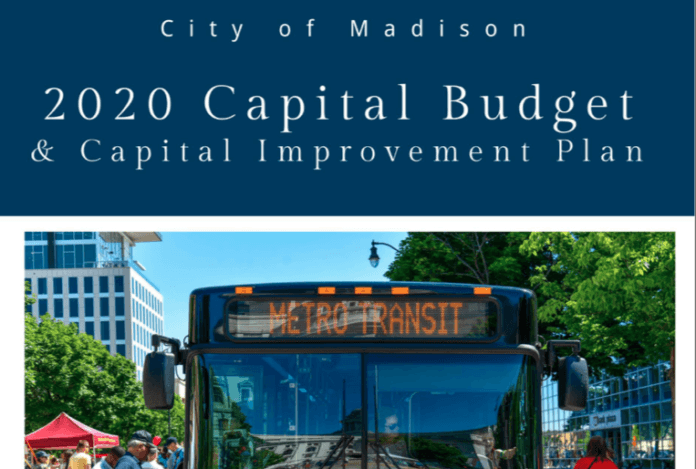
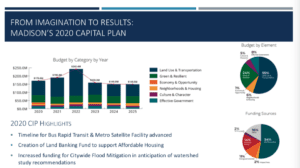
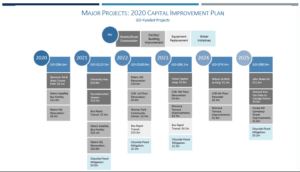
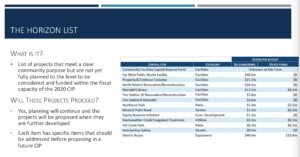
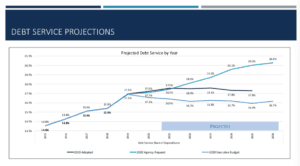
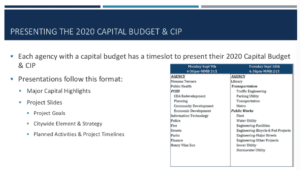
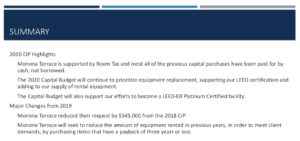
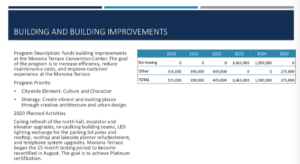
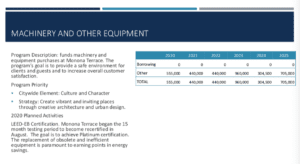
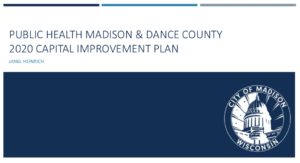
 </a
</a